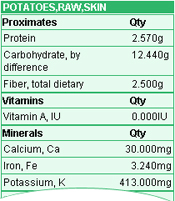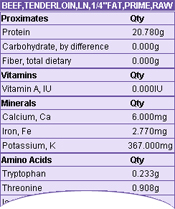|

Nutrient Database
The NutrientDB is a database containing over 6,000 foods and their complete
nutritional breakdown. The database is compiled by the U.S. Dept of Agriculture
(USDA) and is freely available at their website as a set of
ASCII text files.
In keeping with
this spirit of free information and open source software, this website has taken
this freely available data and developed a web based application to access it.
The code is written in PHP 5 and uses a MySQL 4.x backend database.
Go here to download.

What exactly is a "nutrient database" ?
The nutrient database contains scientific data about the nutritional content of
many foods (three examples are shown on this page). The nutrients are classified into 6 groups:
| 1. Proximates | (eg. protein, starch, fiber, water, glucose) |
| 2. Vitamins | (eg. vitamin C, A, D, thiamin, riboflavin) |
| 3. Minerals | (eg. calcium, iron, potassium, zinc) |
| 4. Amino Acids | (eg. tryptophan, lysine, aspartic acid) |
| 5. Lipids (fats) | (eg. Cholesterol, Fatty acids saturated, monounsaturated) |
| 6. Other | (eg. alcohol, cffeine, carotene) |
To see the complete list of nutrients contained in the NutrientDB, click here.
As there are around 120 nutrients, the NutrientDB allows you to select only those nutrients
you wish to retrieve information about.
Benefits and Uses
The NutrientDB is an extremely useful tool to athletes and health professionals. It also of great value to anyone who wishes to maintain
a healthy lifestyle. Anyone can plan and create healthy meals using the NutrientDB as a tool to retrieve information on how much fat,
carbs, or sugars are in a particular ingredient. It can also be used by those who suffer from any medical condition that relates to food
intake, eg. diabetes sufferers, or heart patients. With NutrientDB, those at risk can find out exactly what is in the foods that they will
eat, and therefore can help gaurd against their illness.
|
|